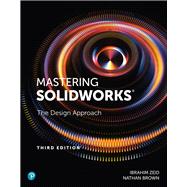Fully updated for SolidWorks 2021, Mastering SolidWorks, Third Edition, thoroughly illuminates solid modeling CAD techniques for developing parts, assemblies, and drawings. Additional specializations, SolidWorks toolboxes, and manufacturing techniques are also covered, including sheet metal, injection molding, and animation. New illustrations reflect SolidWorks 2021 throughout, and this edition fully reflects changes in workflow since SolidWorks 2014.
Mastering SolidWorks can develop CAD skills in students with little or no solid modeling expertise, help more advanced students hone specialized skills, and prepare any SolidWorks user for SolidWorks Associate (CSWA) or Professional (CSWP) certification. Written especially for beginners and intermediate users, it will also be valuable to experienced users requiring specialized knowledge, to companies training their own professionals, and to all schools teaching engineering, design, or 3D modeling.
- Understand SolidWorks as a powerful design/manufacturing system, not just a piece of software
- Learn key modeling concepts for working efficiently, avoiding errors, and transferring your skills anywhere
- Rapidly create, assemble, document, and visualize parts
- Embed “design intelligence” to make parts easier to edit and manufacture
- Master part modeling: from basic features, drawings, and assemblies to advanced curves, surfaces, and sustainable designs
- Develop and analyze parts using tolerances and SolidWorks analysis tools
- Manufacture parts with rapid prototyping, numerical control machining, and injection molding










